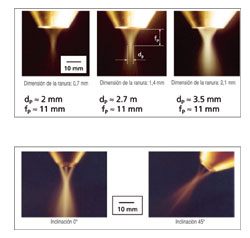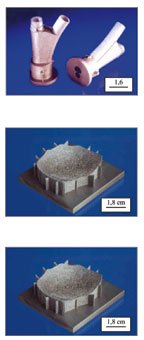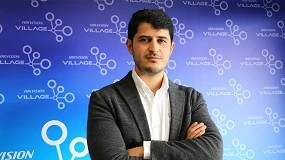The laser on techniques of rapid manufacturing and surface treatments
A. Gasser, C. Over, w. Meiners, g. Vitr, e. Willenborg, C. Johnigk, N. Pirch, i. Kelbassa, k. Wissenbach
Fraunhofer Institute Lasertechnik
Moving in the simulation of the process of laser cladding, which will help to understand the correlation between the parameters of the process, warming, and the material flow.
The cleaning is another interesting application of the laser field. The latest are oriented to the cleaning of electronic devices: weldable lacquers, pollution, waste of polymers and oxide coatings must be removed from the surface. Radiation laser pulsed with pulses of 10 to 250 ns in duration is used.Due to the high intensity and short interval of the interaction, the non-metallic coatings evaporate without that affect the metal surface of the substrate.
Another field of application of lasers is the polishing surfaces. Melting a small layer of the material the surface roughness alisan. The potential uses of this process are aimed at nailing the injection moulds and medical devices.
The process can be used for the direct manufacture of pieces of metal from materials in series of selective sintering by laser (SLM). Densities of 100% can be obtained thanks to a methodology based full cast of the material in powder form.
The materials under investigation are the stainless steel 1.4404, 1.2343 tool steel and titanium TiAl6V4. The manufacture of functional prototypes out of the materials in series allow a saving of time versus conventional processes. Another objective is the implementation of the SLM for the manufacturing of small series as the individual production for implant medical, which allows high flexibility.

Coating by laser
The situation has changed since that were developed and introduced to the market of high power diode lasers and ND: YAG lasers pumped by diodes. He has also made progress in the automation and the plan of laser coating process.This series of progress led to a demand for laser repair tools [5] and the [6] turbine engine parts.
During the laser lining, provided material and a thin layer of the substrate melt through the beam laser (Figure 1). The pre-recubrimiento, for example by heat projection or galvanic deposition, requires more time and is more expensive, at the same time which is efficient only for covering large areas. Supply "in-situ" involves injecting the material provided in the area of the interaction between the laser beam and the substrate in the form of wire or powder. Given that the use of this limited the variety of materials, powder injection is the method which has more advantages. Powders used for coating by laser must have a size of particle between 20 µm and 200 µm. The main features of power are achieved with a spherical shape of the particles, typical of atomised powders.

Cleaning and polishing
Weldable lacquers, pollution, waste of polymers and oxide layers have to be removed from the surface, especially in the subsequent Assembly and coating processes, requiring a clean surface.
So far, the conventional techniques of cleaning have been based on chemical or mechanical processes methods that are quite expensive compared to laser treatment. To prevent these disadvantages, we recommend the techniques of laser radiation.
Due to the high intensity and short temporary interaction, coating layers evaporate while the metal surface of the substrate is not affected...

Selective cast with laser
These features increase the scope for the technology of rapid prototyping to the fast manufacture of functional parts and tools in series. The roughness and dimensional accuracy are decisive factors for the use and the industrial acceptance of the SLM process.
Conclusions
Future research will focus on the automation and control of the process that will increase the reliability of the process.
The use of materials of series in the SLM offers new possibilities in the creation of prototypes and in the direct production of parts. The possibility to produce pieces with geometric features supplements the methods of conventional manufacturing in various fields of use such as the manufacture of implants medical, aerospace applications and manufacture of tools and moulds. Additional research in cooperation with various industrial partners will be conducted with the objectives to achieve more complex geometries and the extension of the range of the materials and composite materials.
The objectives with respect to the tools and molds will be a further reduction in manufacturing time, increased quality by cooling conformal and life cycles.
References
- B. Schürmann, Vitr g., Wissenbach k., Randschichtbehandlung mit Hochleistungs - Diodenlasern, LaserOpto 1, 1999
- Richter a., S. Nowotny, Naumann t, Beyer e., "Auftragschweißen mit dem Hochleistungs-Diodenlaser". LaserOpto, 1, 1999,
- Beyer, e., Wissenbach, k. (eds.), Oberflächenbehandlung mit Laserstrahlung, Springer Verlag, 1998
- Richter a., S. Nowotny, Naumann t, Beyer e., Auftragschweißen mit dem Hochleistungs-Diodenlaser, LaserOpto, 1, 1999
- Eimann, k., Instandsetzung von Werkzeugen mit Laserstrahlung, Proc. AKL 2000, 169-180
- Stimper, B., Verlängern von Verdichterschaufeln durch Laser-Pulver - ILA 2000, Technikberichte MTU, Auftragschweißen, www.mtu.de
- Gebhardt, a.: Rapid Prototyping-Werkzeuge für die schnelle Produktentwicklung, Carl Hanser Verlag München, Wien, 2000
- Meiners, w.: Direktes Selektives Laser Sintern einkomponentiger metallischer Werkstoffe, Dissertation RWTH Aachen, 1998
- Meiners w., Over C., Wissenbach, k., Poprawe, r.: Direct generation of metal parts and tools by Selective Laser Powder Remelting (SLPR), Proceedings of the Solid Freeform Fabrication Symposium, Austin Texas 1999
- CRAFT Project BE S2 5412 "Direct generation of tools and functional prototypes", Final report, Aachen, 2001
- Meiners, w., Over C., Wissenbach, k., Poprawe, r.: Herstellung von Werkzeugteilen mittels Selective Laser Melting (SLM), 10. Würzburger Werkzeugtage, Proceedings, Sept. 27-28. 2000, Würzburg, Germany






